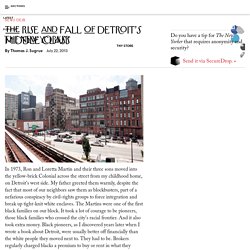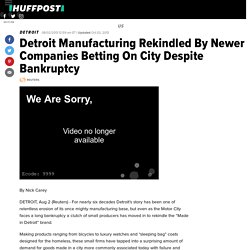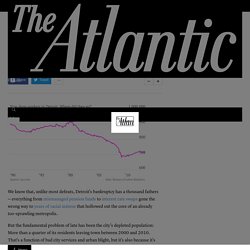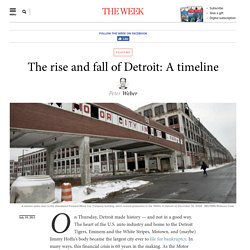

I'm cool
The Rise and Fall of Detroit’s Middle Class. In 1973, Ron and Loretta Martin and their three sons moved into the yellow-brick Colonial across the street from my childhood home, on Detroit’s west side.

My father greeted them warmly, despite the fact that most of our neighbors saw them as blockbusters, part of a nefarious conspiracy by civil-rights groups to force integration and break up tight-knit white enclaves. The Martins were one of the first black families on our block. It took a lot of courage to be pioneers, those black families who crossed the city’s racial frontier.
And it also took extra money. Black pioneers, as I discovered years later when I wrote a book about Detroit, were usually better off financially than the white people they moved next to. Ron and Loretta were pioneers in another way. It was not always this way. But by the time the Martins moved in, those blue-collar jobs were disappearing. Public employment, of course, did not come cheaply. Thomas J. Photograph by Bill Pugliano/Getty. Detroit Manufacturing Rekindled By Newer Companies Betting On City Despite Bankruptcy. By Nick Carey DETROIT, Aug 2 (Reuters) - For nearly six decades Detroit’s story has been one of relentless erosion of its once mighty manufacturing base, but even as the Motor City faces a long bankruptcy a clutch of small producers has moved in to rekindle the “Made in Detroit” brand.

Making products ranging from bicycles to luxury watches and “sleeping bag” coats designed for the homeless, these small firms have tapped into a surprising amount of demand for goods made in a city more commonly associated today with failure and decline. “Our customers come from all walks of life and are looking for a little bit of soul and something that is authentically Detroit,” said Eric Yelsma, founder of Detroit Denim Co., which produces hand-made jeans. “We can’t make them fast enough.” JPMorgan Chase Commits Over $1.3 Million to Increase Skills Training and Job Growth in Detroit. September 27, 2016 (Detroit, MI) – JPMorgan Chase & Co. is investing over $1.3 million to increase the number of Detroiters receiving skills training for in-demand jobs and to strengthen partnerships between job seekers, local employers and training providers, the firm announced today.

As part of JPMorgan Chase’s $100 million commitment to the city’s economic recovery, the new grants will support the Detroit Employment Solutions Corporation, United Way for Southeastern Michigan and Corporation for a Skilled Workforce (CSW). Specifically, the investments will create an innovative and new leadership development academy for local workforce professionals, improve connections between Detroiters and existing job openings in growing local industries and address the skills mismatch between local employers and job seekers. Earlier this year, JPMorgan Chase and CSW released a series of reports that examined ways to strengthen Detroit’s workforce systems. About JPMorgan Chase JPMorgan Chase & Co. What Bankrupted Detroit: China? Or Robots? - The Atlantic. We know that, unlike most defeats, Detroit's bankruptcy has a thousand fathers -- everything from mismanaged pension funds to interest rate swaps gone the wrong way to years of racial animus that hollowed out the core of an already too-sprawling metropolis.

But the fundamental problem of late has been the city's depleted population: More than a quarter of its residents leaving town between 2000 and 2010. That's a function of bad city services and urban blight, but it's also because it's hard to make a living there. You can see that reflected in the chart above. Anatomy of Detroit’s Decline - Interactive Feature. Mayor Coleman A. Young of Detroit at an event in 1980. Richard Sheinwald/Associated Press The financial crisis facing Detroit was decades in the making, caused in part by a trail of missteps, suspected corruption and inaction. Here is a sampling of some city leaders who trimmed too little, too late and, rather than tackling problems head on, hoped that deep-rooted structural problems would turn out to be cyclical downturns.
Charles E. Edward Jeffries, who served as mayor from 1940 to 1948, developed the Detroit Plan, which involved razing 100 blighted acres and preparing the land for redevelopment. Albert Cobo was considered a candidate of the wealthy and of the white during his tenure from 1950 to 1957. What caused the decline of Detroit? - Quora. Detroit Bankrupt: To See Detroit's Decline, Look at 40 Years Of Federal Policy. The rise and fall of Detroit: A timeline. Sign Up for Our free email newsletters On Thursday, Detroit made history — and not in a good way.

The heart of the U.S. auto industry and home to the Detroit Tigers, Eminem and the White Stripes, Motown, and (maybe) Jimmy Hoffa's body became the largest city ever to file for bankruptcy. In many ways, this financial crisis is 60 years in the making. As the Motor City faces an uncertain future, here's a look back at some key dates in the long, storied past of one of America's great cities: July 24, 1701Antoine de La Mothe Cadillac establishes a French settlement, Fort Ponchartrain du Détroit (the strait), along with 100 French soldiers and an equal number of Algonquins. 1760Britain wins the city from the French. 1796U.S. forces capture Detroit from the British.
Feb. 1, 1802Detroit becomes a chartered city, covering about 20 acres. 1827Detroit adopts its forward-looking city motto: Speramus Meliora; Resurget Cineribus (We hope for better days; it shall rise from the ashes). 1899Ransom E.